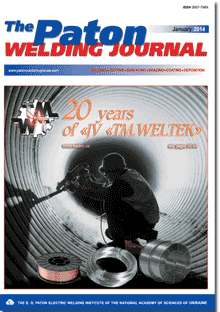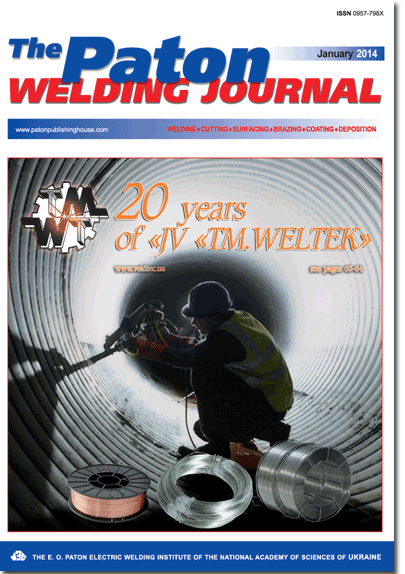| 2014 №01 (02) |
DOI of Article 10.15407/tpwj2014.01.03 |
2014 №01 (04) |

The Paton Welding Journal, 2014, #1, 20-24 pages
QUASI-CRYSTALLINE ALLOYS-FILLERS FOR COMPOSITE LAYERS PRODUCED USING METHOD OF FURNACE SURFACING
E.V. SUKHOVAYA
O. GoncharDnepropetrovskNationalUniversity. 72 Gagarin Ave., 49010, Dnepropetrovsk, Ukraine. E-mail: sukhovaya@ukr.net
Abstract
Structure and properties of macro-heterogeneous composite layers produced using method of furnace surfacing were investigated. As the fillers the quasi-crystalline alloys Al-Cu-Fe, Al-Co-Cu and Al-Co-Ni were used. As the bonds the alloys based on aluminium and copper were used. It was shown that the method of furnace surfacing allows obtaining the content of quasi-crystalline icosahedral y-phase of not less than 30vol.% in the structure of composite layers strengthened by Al-Cu-Fe alloy-filler, and the content of quasi-crystalline decagonal D-phase of up to 55 vol.% in the structure of composite layers with alloys-fillers Al-Co-Cu and Al-Co-Ni. The regularities of formation of interfaces between filler and bond during surfacing are explained by realization of solution-diffusive mechanism of processes of contact interaction. The primary dissolution of crystalline phases of alloys-fillers was established, which leads to penetration of molten bonds inside the filler along the boundaries of crystals of the quasi-crystalline phase. The increase in intensity of processes of dissolution of filler crystalline phases in use for surfacing of Cu-based bonds results in their complete recrystallization in the process of cooling at retaining not-dissolved inclusions of quasi-crystalline phase in the structure of composite layers. To produce the surfaced layers operating under the conditions of dry friction, the composite material based on tin bronze Br.Ots 10-2 armored by the Al-Co-Ni alloy-filler was recommended. The composite material with bond of brass L62 and alloy-filler Al-Co-Cu has the maximum resistance in oxide media. 11 Ref., 1 Table, 4 Figures.
Keywords: composite layer, furnace surfacing, quasi-crystalline phase, interphase interaction, dissolution, corrosion resistance in oxide media, tribotechnical properties
Received: 30.09.13
Published: 28.01.14
References
1. Netesa, I.V., Dudko, D.A., Maksimovich, B.I. et al. Method of wear-resistant surfacing. USSR author's cert. 562393. Int. Cl. B 23 K 9/04, B 22 D 19/08. Fil. 18.07.1975. Publ. 08.06.1977.
2. Danilov, L.I., Rovenskykh, F.M. (1979) Surfacing of parts of charging devices of blast furnace by composite alloy. Metallurg, 1, 12-15.
3. Dudko, D.A., Maksimovich, B.I., Zelenin, V.I. et al. (1975) Wettability of wear-resistant components of composite alloys by ligaments on copper-nickel-manganese base. Avtomatich. Svarka, 5, 5-6.
4. Dudko, D.A., Zelenin, V.I., Netesa, I.V. et al. (1977) Novel wear-resistant surfacing composite alloys. In: Wear-resistant surfacing materials on the base of refractory compounds. Kiev: Naukova Dumka, 3-5.
5. Bystrov, V.A., Bystrov, A.V., Dzodziev, G.T. et al. (1979) Investigation of properties of composite alloys on carbide titanium base. In: Properties and tests of deposited metal. Kiev: PWI, 131-135.
6. Borovikova, M.S. (1980) Main principles of contact interaction of refractory borides with some nontransition metals. In: Phase interphases and their properties. Kiev: IAM, 72-79.
7. Samsonov, G.V., Panasyuk, A.D., Borovikova, M.S. (1973) Interaction of refractory borides with liquid metals of iron family. Poroshk. Metallurgiya, 6, 51-57.
8. Huttunen-Saarivirta, E. (2004) Microstructure, fabrication and properties of quasicrystalline Al-Cu-Fe alloys: A review. J. Alloys Comp., 363, 150-174. https://doi.org/10.1016/S0925-8388(03)00445-6
9. Mamykin, E.T., Kovpak, M.K., Yuga, A.I. et al. (1973) Complex of machines and procedure for determination of antifriction properties of materials in sliding friction. Poroshk. Metallurgiya, 1, 67-72.
10. Tsai, A.-P., Inoue, A., Masumoto, T. (1989) A stable decagonal quasicrystal in the Al-Cu-Co system. Mater. Transact. of JIM, 30(4), 300-304. https://doi.org/10.2320/matertrans1989.30.300
11. Godecke, T., Ellner, M. (1996) Phase equilibria in the aluminum-rich portion of the binary system Co-Al and in the cobalt/aluminum-rich portion of the ternary system Co-Ni-Al. Z. Metallkunde, 87, 854-864.
Suggested Citation
E.V. SUKHOVAYA (2014) QUASI-CRYSTALLINE ALLOYS-FILLERS FOR COMPOSITE LAYERS PRODUCED USING METHOD OF FURNACE SURFACING. The Paton Welding J., 01, 20-24.The cost of subscription/purchase order journals or individual articles
| Journal/Currency | Annual Set | 1 issue printed |
1 issue |
one article |
| TPWJ/USD | 384 $ | 32 $ | 26 $ | 13 $ |
| TPWJ/EUR | 348 € | 29 € | 24 € | 12 € |
| TPWJ/UAH | 7200 UAH | 600 UAH | 600 UAH | 280 UAH |
| AS/UAH | 1800 UAH | 300 UAH | 300 UAH | 150 UAH |
| AS/USD | 192 $ | 32 $ | 26 $ | 13 $ |
| AS/EUR | 180 € | 30 € | 25 € | 12 € |
| SEM/UAH | 1200 UAH | 300 UAH | 300 UAH | 150 UAH |
| SEM/USD | 128 $ | 32 $ | 26 $ | 13 $ |
| SEM/EUR | 120 € | 30 € | 25 € | 12 € |
| TDNK/UAH | 1200 UAH | 300 UAH | 300 UAH | 150 UAH |
| TDNK/USD | 128 $ | 32 $ | 26 $ | 13 $ |
| TDNK/EUR | 120 € | 30 € | 25 € | 15 € |
AS = «Automatic Welding» - 6 issues per year;
TPWJ = «PATON WELDING JOURNAL» - 12 issues per year;
SEM = «Electrometallurgy Today» - 4 issues per year;
TDNK = «Technical Diagnostics and Non-Destructive Testing» - 4 issues per year.


